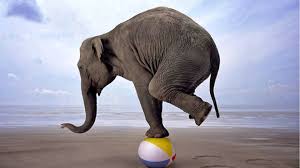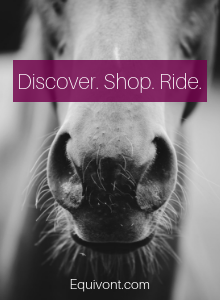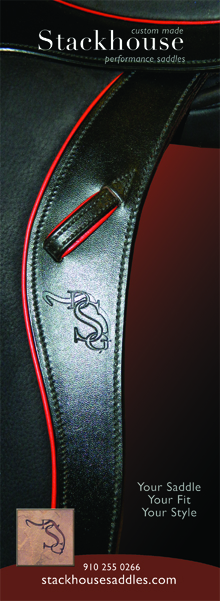Search the Site
Lauren's Blog post # 5: It's a Balancing Act

When it comes to the fundamentals of riding and helping our horses perform at the peak of their potential, it almost always boils down to the physics and biomechanics of horse and rider.
At the most basic level, a horse and a rider pair is comprised of two things: the horse (the object exerting motion), and the rider (the one maintaining, or attempting to maintain, equilibrium with the object in motion). In an ideal world the rider is in complete control, has absolute synchronicity with the horses’ motions, and need not work overbearingly to maintain this equilibrium. This scenario, though attainable, takes years of development and training on behalf of both parties. Breaking it down into its simplest form, however, can take a lot of the guesswork out of the question “where should my body be in relation to my horse?”
When we think about the mechanics of human motion, we can think about how we walk and move forward. In order to exert forward motion, we must thrust our center of mass in the direction of travel and maintain that forward thrust (or slight forward posture) to sustain energy moving ahead. Our center of balance comes forward in order to continue moving in that direction, and our legs work to both catch and maintain that forward energy with each step. We, as bipedal humans, rely on this balance of weight heavily; lean further into your gait and your steps will increase in speed and size to maintain balance. Lean back out of it and you will shorten your gait and slow down.
When you look at bipedal versus quadrupedal motion mechanics, the amount and type of thrust needed to create forward motion changes. As weight is distributed over a larger area, more push from behind is required to produce forward motion, as it is not so easy to alter the center of balance. Think of the stability of a table versus the stability of a standing ladder (not of the fold out variety, thus bipedal); shifting the center of balance is much easier on the latter, pun intended.
Quadrupeds, like horses, rely much less on back to forward weight shift and more on the thrust from behind. If you can relate to how unbalanced a horse carrying itself “on the forehand” feels, it’s an easy reminder that humans and horses biomechanics are quite different within the parameters of generating thrust. A horses center of mass lies somewhere underneath the withers and behind the shoulder in the girth area, varying slightly dependent on confirmation. When a horse is working on the forehand, the center of mass comes forward. When a horse is moving in balance, the center of mass remains relatively static and/or moves backwards and upwards as the horse shifts more weight onto its hindquarters, freeing the front end for soft and responsive movement.
To illustrate the difference in mechanics of bipedal versus quadrupedal motion, think of the way that a Segway operates. A Segway is a bipedal tool used to mimic the mechanics of human motion. Lean forward from a standstill, and the Segway must roll as to maintain equilibrium. So long as we are leaning into the motion the Segway will continue its forward thrust, as its inner technical components have been programmed to respond in exactly the way that we, as humans, generate and maintain inertia. Now imagine sitting straddled over a quad, or four wheeled ATV, on flat ground. Leaning your weight forward is not going to shift the weight of the quad such that moving ahead is the only way for it to resist falling on its front end. Rather, you are loading and compressing the front end of the quad as your weight and balance moves in that direction. Beyond compensating for changes in momentum, a forward or backward change in balance will change the ratio of weight being exerted on either end of the quad.
When we think about riding and equestrian mechanics, as the horse steps into motion the withers and shoulders actually elevate in relation to the hind end dropping as to allow the legs to swing and reach underneath, grab the ground, and generate forward propulsion. Thus, shifting our balance forward and ahead of our horse’s center of mass compresses this vital function, encourages work on the forehand, and poses a hindrance to the horse maximizing potential in movement.
This is not to say that we can’t draw parallels in human and equine motion, but we must do so understanding where the horse and the human often work on alternate paradigms. Think of the way humans start a foot race versus the way horses start. Lined up in the blocks, the humans weight is so forward that their hands must be placed on the ground, putting themselves in the optimal position to generate thrust and speed. Horses, on the other hand, stand in the starting gate no different than they would stand in the crossties. Their forward motion comes from massive exertions of push from behind, and it goes without saying that they can reach much faster speeds than their human counterparts. If anything, more efficient equine propulsion comes from shifting weight backwards and spring loading the hind end, and not leaning out ahead.
The pinnacle of riding is in collection, creating a horse that moves forward, explosively at times, with most all of its weight on its hind end; a feat which, given our human biomechanics, is largely unattainable and inefficient for us. Our job as riders is to create an environment in which our horses can work with as little interference on our behalf as is possible. Though we give our horses signals as to which direction to travel and how fast, etcetera, etcetera, we are simply active passengers. The horse, though it may move as an extension of our legs, is ultimately carrying us. This brings me back to the idea that the horse and rider pair is comprised of two things: the one exerting motion, and the one maintaining equilibrium with the motion.
This phenomenon is something we take part in every day in many ways. When we step onto, for instance, a train, we are the object maintaining equilibrium with the object in motion; the train. As the train rolls into motion and generates speed, we must lean forward into that thrust as to maintain our own balance lest we topple backwards. Once that train has reached its maximum speed and our body catches up, we no longer have to lean forward as we have met equilibrium in momentum. Hence the reason that we can be flying at over 500 mph in the sky and, save for turbulence, our airline quality Merlot stays perfectly level in its little Dixie Cup. Imagine standing on a train, traveling smoothly at a consistent speed, and leaning into the direction of travel. Because you have met equilibrium with the train, any shift in weight is going to be felt as an imbalance.
The same rules apply when we are astride a horse moving through the gaits and motions associated with our field of riding. As our horse increases and decreases speed, we must alter our center of balance as not to get stuck behind the motion or fall ahead of it; both options hinder our horse’s ability to perform at full capacity and increase our chances of a potential fall. Likewise, when we ask our horses to maintain a consistent inertia, we must maintain our equilibrium over the horses center of mass as not to let our weight come ahead of or behind that line of reference; thus avoiding an imbalance our horses can surely feel throughout motion.
This is not to say that we can’t draw parallels in human and equine motion, but we must do so understanding where the horse and the human often work on alternate paradigms. Think of the way humans start a foot race versus the way horses start. Lined up in the blocks, the humans weight is so forward that their hands must be placed on the ground, putting themselves in the optimal position to generate thrust and speed. Horses, on the other hand, stand in the starting gate no different than they would stand in the crossties. Their forward motion comes from massive exertions of push from behind, and it goes without saying that they can reach much faster speeds than their human counterparts. If anything, more efficient equine propulsion comes from shifting weight backwards and spring loading the hind end, and not leaning out ahead.
The pinnacle of riding is in collection, creating a horse that moves forward, explosively at times, with most all of its weight on its hind end; a feat which, given our human biomechanics, is largely unattainable and inefficient for us. Our job as riders is to create an environment in which our horses can work with as little interference on our behalf as is possible. Though we give our horses signals as to which direction to travel and how fast, etcetera, etcetera, we are simply active passengers. The horse, though it may move as an extension of our legs, is ultimately carrying us. This brings me back to the idea that the horse and rider pair is comprised of two things: the one exerting motion, and the one maintaining equilibrium with the motion.
This phenomenon is something we take part in every day in many ways. When we step onto, for instance, a train, we are the object maintaining equilibrium with the object in motion; the train. As the train rolls into motion and generates speed, we must lean forward into that thrust as to maintain our own balance lest we topple backwards. Once that train has reached its maximum speed and our body catches up, we no longer have to lean forward as we have met equilibrium in momentum. Hence the reason that we can be flying at over 500 mph in the sky and, save for turbulence, our airline quality Merlot stays perfectly level in its little Dixie Cup. Imagine standing on a train, traveling smoothly at a consistent speed, and leaning into the direction of travel. Because you have met equilibrium with the train, any shift in weight is going to be felt as an imbalance.
The same rules apply when we are astride a horse moving through the gaits and motions associated with our field of riding. As our horse increases and decreases speed, we must alter our center of balance as not to get stuck behind the motion or fall ahead of it; both options hinder our horse’s ability to perform at full capacity and increase our chances of a potential fall. Likewise, when we ask our horses to maintain a consistent inertia, we must maintain our equilibrium over the horses center of mass as not to let our weight come ahead of or behind that line of reference; thus avoiding an imbalance our horses can surely feel throughout motion.
This maintenance of balance is attainable through every style and position of riding. The old adage “vertical line through the ear, shoulder, hip, and heel” is great at the standstill and slow gaits for building postural strength, but in moving beyond the basics it becomes clear very fast that many disciplines require different positions for optimal performance and shock absorption. Look at the drastic change from a western rider to that of an eventer going full tilt on the cross-country course. At first glance one might appear to be seated upright in the saddle and the other leaning out ahead over the tack, however, if done correctly, both are riding in absolute equilibrium; not exerting forward or backward pressures or imbalances upon their mounts. An experienced and well-conditioned rider can balance out of the tack over the horses center of mass with arms outstretched.
Think of your postural balance as you would do a squat; your feet a shoulder-width apart, grounded into the floor as they would be in the stirrups. This exercise gives solid insight as to how a rider (with appropriately short stirrups) can change hip angle drastically without changing the balance. Stand upright as though you were sitting up in the saddle. Aside from your core keeping you erect, there is not much happening in the way of strenuous muscle work to maintain steadily centered. As you lower into your squat, given that your back does not round and your knees to not buckle inward, you will feel your seat press back as to keep your balance over center. As you lower down one bit at a time, play with your front to back balance. Feel how much strain falling out of balance, even slightly, puts on your body, and imagine the compounding effect this shift in balance has on your horse.
This is not to say there are not times in which we can use this front to back shift in motion progressively. Many times in encouraging our horses to roll forward into motion or increase the pace we will accompany activity in the leg and seat with a slightly more forward tilt, given that the horse can feel our shift into the forward direction and take the hint as we prepare our bodies to remain stable through the change in momentum. Think of a barrel racer on the home stretch encouraging their partner to gallop faster and faster. The same can be said for downward and halt transitions, as we often sit deep and bring our shoulders back when coming to a stop. However, once the desired pace, or halt, is achieved, the rider must return to a state of balance, wherever that may be with regards to the horses center of mass. To keep our weight out of equilibrium by means of leaning forwards or backwards in relation to our horses center of mass while expecting our horse to maintain a steady pace is both a hindrance to performance and dulling our horse to the aid if and when we need to call it into action.
Many of us want that seamless feel in motion with our horses, but in applying strict human principle without parlaying the conversion of bipedal to quadrupedal motion we fail to accommodate the horse in its optimal state. It is not our job as riders to let our balance come forward as though we were walking to maintain forward motion, as we are not the ones exerting thrust but instead the ones maintaining equilibrium upon the object exerting thrust. Assuming the former places the horse, a quadruped, into the confines of bipedal motion. Additionally, it begs the assumption that we, as passengers, are somehow responsible for creating forward thrust. Beyond giving the horse the signal to move forward, thrust comes entirely from the horse itself.
Finding the center of balance is no easy task in itself and requires years of training, as being straddled upon a horse is not a position humans fall into naturally. Generally, beginning riders follow a pattern of comfort and instinct. Thus, in a seated position the rider in the early stages of learning will often keep their legs ahead of them as though they were seated in a chair, as this is what they know to be safe and comfortable. Additionally, when they feel insecure they tend to roll towards the neck, instinctually reaching for what they feel is solid and in front of them, letting their lower leg swing backwards. It takes much trial and error to realize that these positions, in fact, pull you out of balance and increase your chances of becoming unseated.
To further complicate issues, maintaining the center of balance can take a different shape given each horse’s unique confirmation and individual default center of gravity. On a horse that is built very uphill in the withers, a rider must find an ever so slightly different feel of equilibrium with regards to their body to body connection than they would on a horse who is built level or even downhill; a skill which, again, takes many years to hone. Thus, the surest way towards mastering this great balancing act is time in the saddle, a trainer who can identify and foster correct biomechanics, and a humble understanding that progress is never linear.
Ultimately, it is our job as riders to allow our horses the freedom in movement to do their work void of impediments and in a way that promotes the development of soft responsiveness, regardless of discipline. We all want that harmonious partnership with our horses in which our thought becomes their action and our movement becomes their own. This end goal, though often mimicked and forced, can only be achieved through the mastery of balance.
Thus, to answer the question “where should my body be in relation to my horse?” we must conclude that the best response is “within equilibrium.” An answer ponderously vague to the rider who is on the early stages of their journey, and seldom mastered by those rounding the last turn of their equestrian careers. This in itself presents the beauty of the sport, because when it comes down to it, all of us are students of the horse; in a perpetual state of growth and absorption of knowledge. The biggest favor we can do for our equine partners is to never stop seeking that wisdom. Only with awareness can we press forward in our equestrian endeavors and have a better ride from one day to the next. It is, after all, but a balancing act.






